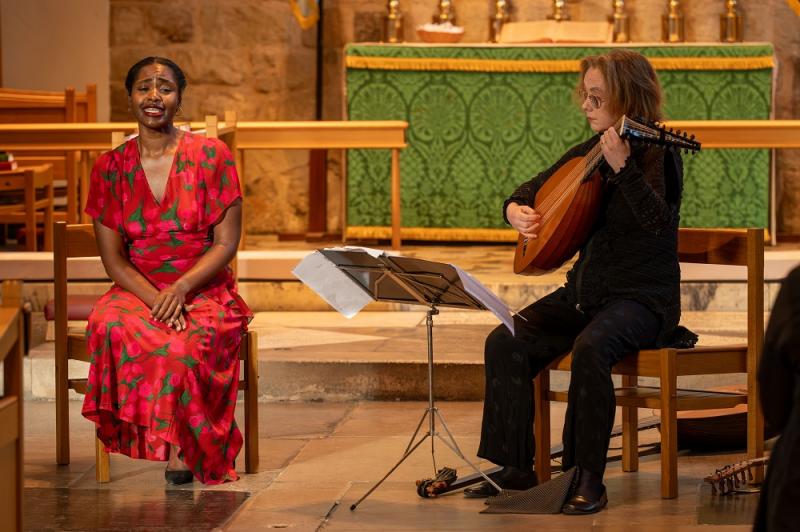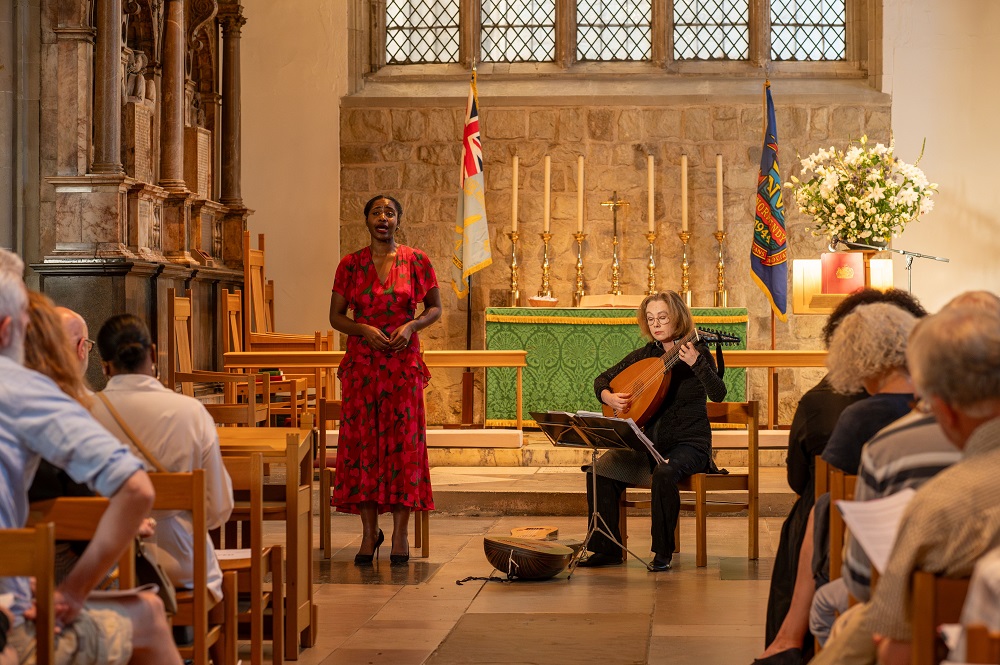Nardus Williams, Elizabeth Kenny, Spitalfields Music Festival review - layers behind a sweet Tower hour | reviews, news & interviews
Nardus Williams, Elizabeth Kenny, Spitalfields Music Festival review - layers behind a sweet Tower hour
Nardus Williams, Elizabeth Kenny, Spitalfields Music Festival review - layers behind a sweet Tower hour
Programming and presence undermined by zero visibility for many

Behind this poignant, simple-seeming hour of music for soprano and lute(s) lay a spider-web of connections between outsiders in the City: rebels, prisoners, immigrants, Black Londoners. Elizabeth Kenny’s programme note wove it all together brilliantly; we could have heard even more of her talking during the concert. Most of us could have done with seeing more than 15 minutes of the wonderful Nardus Williams, too.
On the way to the Tower I’d been reading the chapter in Antonio Pappano’s marvellous autobiography where he writes about coaching young artists and declares, “I am merciless that the eyes of the singer are a feature of their presentation”. Williams has marvellous eyes, and is a born communicator, yet such is the layout of atmospheric St Peter ad Vincula, bright in the early evening light, that probably not as much as a quarter of the audience would have witnessed the full deal other than in the four dramatic songs, where she rose from her seat beside Kenny to enthral us all (pictured below).By the late stage at which the first of them arrived, I’d been standing against a pillar at the back of the church for the first two sequences. Terraced seating might not have been an option in the venue, but why did no one think of a raised platform on which to seat soprano and lutenist?  Inevitably, and especially given the church acoustic, one hears more of the text when one can see it being produced. In any case, Lanier’s “Nor com’st thou yet”, Hero’s complaint to Leander, was the dramatic high point of a mostly gentle selection. The Spitalfields Music commission from composer/baritone Roderick Williams and Rommi Smith, winner of the Northern Writers’ Prize for Poetry, The Blacke Songs, should have hit the heights, too: Smith takes three Black Tudors (one presumably so) – Lucy Baynham, “Queen of Turnmill Street”; Reasonable Blackman, silk weaver of Southwark, and John Blanke, trumpeter to Henry VIII, and fuses them with speculation in sonnet fantasies that are finer than her too-explanatory note suggested they would be. But Williams R’s setting is disappointingly anodyne, and though Wiiliams N has the brilliant upper register to manage it, too much of the writing lies high. Not the most impactful of official finales to the evening.
Inevitably, and especially given the church acoustic, one hears more of the text when one can see it being produced. In any case, Lanier’s “Nor com’st thou yet”, Hero’s complaint to Leander, was the dramatic high point of a mostly gentle selection. The Spitalfields Music commission from composer/baritone Roderick Williams and Rommi Smith, winner of the Northern Writers’ Prize for Poetry, The Blacke Songs, should have hit the heights, too: Smith takes three Black Tudors (one presumably so) – Lucy Baynham, “Queen of Turnmill Street”; Reasonable Blackman, silk weaver of Southwark, and John Blanke, trumpeter to Henry VIII, and fuses them with speculation in sonnet fantasies that are finer than her too-explanatory note suggested they would be. But Williams R’s setting is disappointingly anodyne, and though Wiiliams N has the brilliant upper register to manage it, too much of the writing lies high. Not the most impactful of official finales to the evening.
Still, there were odd frissons right at the start, with Henry VIII’s music played and sung yards from what remains of his second and fifth wives' decapitated bodies (Chaplain Roger Hall told us compellingly how the masses of the executed were disinterred from the body of the church, but the royals stay put). “Stories that ended in the Tower” gave us poignant and spitied Dowland and Bacheler, to texts by Raleigh and Essex.
We got more from the Italian texts. Nardus’s decorative excellence wove magic around Ferrabosco and Caccini (the best “Amarilli” you could hope to hear). Spanish links to Pepys, who spent time in the Tower during the Restoration and had taken guitar lessons from Italian immigrant Cesare Morelli, gave us a spirited segue from a wistful Chaconne by Francisco/Francisque Corbetta to Sepan’s “Todos que muero”, and the most masterly of the English word settings, Purcell’s “O Solitude”, linked him to poet Katherine Philips. So many connections in such an exquisite if too-short space of time.
rating
Explore topics
Share this article
The future of Arts Journalism
You can stop theartsdesk.com closing!
We urgently need financing to survive. Our fundraising drive has thus far raised £33,000 but we need to reach £100,000 or we will be forced to close. Please contribute here: https://gofund.me/c3f6033d
And if you can forward this information to anyone who might assist, we’d be grateful.

Subscribe to theartsdesk.com
Thank you for continuing to read our work on theartsdesk.com. For unlimited access to every article in its entirety, including our archive of more than 15,000 pieces, we're asking for £5 per month or £40 per year. We feel it's a very good deal, and hope you do too.
To take a subscription now simply click here.
And if you're looking for that extra gift for a friend or family member, why not treat them to a theartsdesk.com gift subscription?
more Classical music
 La Serenissima, Wigmore Hall review - a convivial guide to 18th century Bologna
This showcase for baroque trumpets was riveting throughout
La Serenissima, Wigmore Hall review - a convivial guide to 18th century Bologna
This showcase for baroque trumpets was riveting throughout
 Sheku Kanneh-Mason, Isata Kanneh-Mason, Wigmore Hall review - family fun, fire and finesse
Intimacy and empathy in a varied mixture from the star siblings
Sheku Kanneh-Mason, Isata Kanneh-Mason, Wigmore Hall review - family fun, fire and finesse
Intimacy and empathy in a varied mixture from the star siblings
 Mahler 8, LPO, Gardner, RFH review - lights on high
Perfect pacing allows climaxes to make their mark - and the visuals aren’t bad, either
Mahler 8, LPO, Gardner, RFH review - lights on high
Perfect pacing allows climaxes to make their mark - and the visuals aren’t bad, either
 Philharmonia, Alsop, RFH / Levit, Abramović, QEH review - misalliance and magical marathon
Kentridge’s film for Shostakovich 10 goes its own way, but a master compels in his 13th hour of Satie
Philharmonia, Alsop, RFH / Levit, Abramović, QEH review - misalliance and magical marathon
Kentridge’s film for Shostakovich 10 goes its own way, but a master compels in his 13th hour of Satie
 Bach St John Passion, Academy of Ancient Music, Cummings, Barbican review - conscience against conformism
In an age of hate-fuelled pile-ons, Bach's gospel tragedy strikes even deeper
Bach St John Passion, Academy of Ancient Music, Cummings, Barbican review - conscience against conformism
In an age of hate-fuelled pile-ons, Bach's gospel tragedy strikes even deeper
 MacMillan St John Passion, Boylan, National Symphony Orchestra & Chorus, Hill, NCH Dublin review - flares around a fine Christ
Young Irish baritone pulls focus in blazing performance of a 21st century classic
MacMillan St John Passion, Boylan, National Symphony Orchestra & Chorus, Hill, NCH Dublin review - flares around a fine Christ
Young Irish baritone pulls focus in blazing performance of a 21st century classic
 Classical CDs: Romance, reforestation and a Rolleiflex
New music for choir, orchestra and string quartet, plus a tribute to a rediscovered photographer
Classical CDs: Romance, reforestation and a Rolleiflex
New music for choir, orchestra and string quartet, plus a tribute to a rediscovered photographer
 First Person: St John's College choral conductor Christopher Gray on recording 'Lament & Liberation'
A showcase for contemporary choral works appropriate to this time
First Person: St John's College choral conductor Christopher Gray on recording 'Lament & Liberation'
A showcase for contemporary choral works appropriate to this time
 Donohoe, RPO, Brabbins, Cadogan Hall review - rarely heard British piano concerto
Welcome chance to hear a Bliss rarity alongside better-known British classics
Donohoe, RPO, Brabbins, Cadogan Hall review - rarely heard British piano concerto
Welcome chance to hear a Bliss rarity alongside better-known British classics
 London Choral Sinfonia, Waldron, Smith Square Hall review - contemporary choral classics alongside an ambitious premiere
An impassioned response to the climate crisis was slightly hamstrung by its text
London Choral Sinfonia, Waldron, Smith Square Hall review - contemporary choral classics alongside an ambitious premiere
An impassioned response to the climate crisis was slightly hamstrung by its text
 Goldberg Variations, Ólafsson, Wigmore Hall review - Bach in the shadow of Beethoven
Late changes, and new dramas, from the Icelandic superstar
Goldberg Variations, Ólafsson, Wigmore Hall review - Bach in the shadow of Beethoven
Late changes, and new dramas, from the Icelandic superstar
 Mahler's Ninth, BBC Philharmonic, Gamzou, Bridgewater Hall, Manchester review - vision and intensity
A composer-conductor interprets the last completed symphony in breathtaking style
Mahler's Ninth, BBC Philharmonic, Gamzou, Bridgewater Hall, Manchester review - vision and intensity
A composer-conductor interprets the last completed symphony in breathtaking style

Add comment